TELL ME About It: AAC Learning with ‘Here Are My Hands’
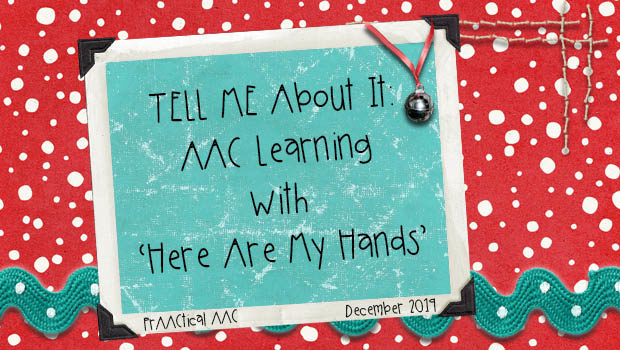
Welcome to a new edition of TELL ME About It, with AAC Specialists Maggie Judson and Jeanna Antrip. Maggie and Jeanna are speech-language pathologists who work in the Assistive Technology Department for the Belleville Area Special Services Cooperative (BASSC) in southern Illinois. They are AT/AAC facilitators and provide evaluations, direct therapy, consultations, and trainings. They’ve collaborated on a series to share their experiences in supporting preschool classrooms that implement the TELL ME program that Lori Wise and I created.
If you missed the earlier posts in this series, you can get caught up using the links below.
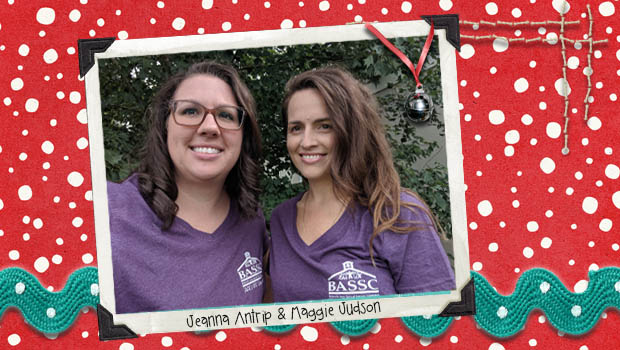
TELL ME About It: AAC Learning with ‘Here Are My Hands’!
TELL ME About Reading: The fourth book in the TELL ME program (Teaching Early Language and Literacy through Multimodal Expression) is “Here Are My Hands.” A perfect book for a preschool classroom, with its repeated phrases, rhyming text, and engaging illustrations. And oh, did we mention it’s full of core words?! We love that the TELL ME program helps us learn how to focus on and provide instruction for not just one core word per book but lots of words – in “Here Are My Hands,” we’ll be addressing GOOD, HAVE, HERE, LIKE, MY, MINE! It’s a great feeling to know that by the end of two weeks with this book, we will have provided instruction in 5+ core words!
Book Focus: Here Are My Hands
- Core Words (BOW WOW Words): GOOD, HAVE, HERE, LIKE, MY/MINE
- Additional Words (Tiger Talk Words): And, Hand, Head
- Concept Vocabulary: body parts
- Special Letter: m
- Book Concept: first sentence (where to start reading)
TELL ME About Writing: According to the ‘Literacy Instruction for Students with Significant Disabilities’ website: “research has shown that typically developing children in kindergarten and first-grade classrooms received an average of 85 opportunities during the school year to learn how to make meaning through writing. Students with significant disabilities who are at this emergent writing stage require JUST AS MANY IF NOT MORE OPPORTUNITIES to write about things that matter to them. The goal is for students with significant disabilities to write and then write more.”
So what does this mean for a preschool or early childhood special education classroom? That for our students to receive “just as many if not more opportunities to write,” we must start providing those opportunities now, as soon as students enter school as 3-year-olds! If we wait, our students will be missing out on opportunities to write, and then to write some more!
Thankfully, we are not on our own to figure out how to make this happen. The TELL ME program totally has our back as it lays out step-by-step how to provide writing instruction through predictable chart writing. Today, we’ll review the next writing lesson included in TELL ME!
- Review core words: Hello repeated exposure! Print each word – GOOD, HAVE, HERE, LIKE, MY, MINE – on a card and allow students the opportunity (aka wait time!) to say the words using natural speech, manual signs, manual communication boards, and/or with their personal speech generating devices.
- Review the predictable chart title: Review the title of the chart (‘HERE is MY body’) that you wrote in the previous lesson to get the stage set for writing!
- Writing! Here’s where you will read over the carrier phrase that goes along with the chart, giving each student a turn to respond to fill in the sentence. Write the response in and add the student’s name at the end in parenthesis. When completed, re-read each phrase, pointing to each word as you read it. You can also work in the special letter ‘m’ by going on a letter hunt with the predictable chart. Students can look for the letter and then say the letter sound when they find it!
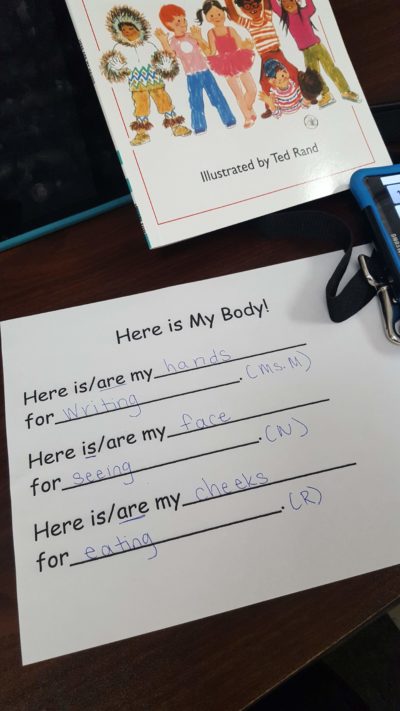
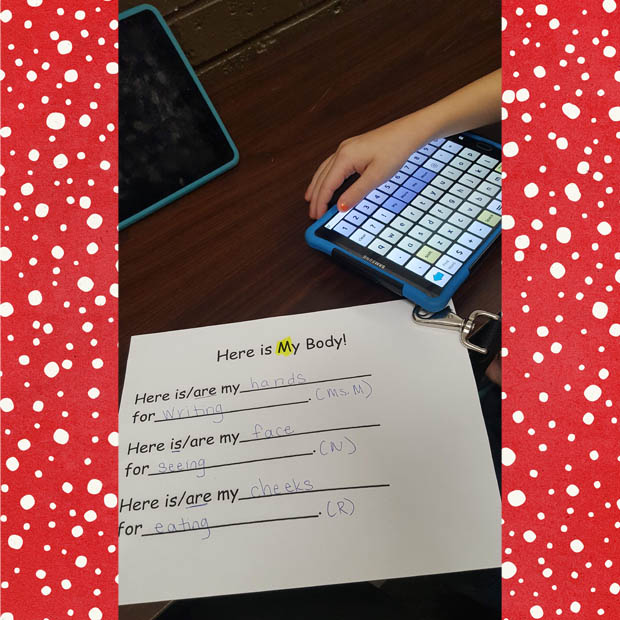
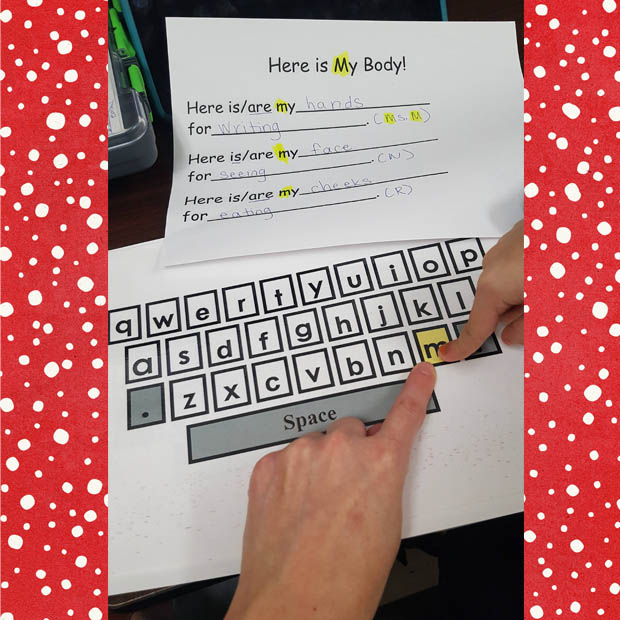
TELL ME More: Below are some specific ideas on how to implement “Here Are My Hands” in your therapy sessions and classrooms TELL ME-style!
- Activity – Circle Time! Circle time is a fabulous time to incorporate those target core words into activities that you already do every day! Here are some examples:
-
- Weather: What’s the weather LIKE today? The sun is GOOD. We HAVE coats because it’s cold outside.
- ABC: Our letter this week is ‘m’. Let’s find our letter ‘m’. What sound does ‘m’ make?
- Attendance: Who is HERE today? Suzy is HERE today! MY teacher is HERE
- Class Jobs: MY job is to be the door holder! I LIKE being the caboose in line.
- Teaching Strategy – Pausing and Wait Time!
Ah, the magical power of wait time. If we were stranded on a deserted island and could only take 3 instructional strategies with us, expectant pausing with appropriate wait time would definitely be one of them!
View wait time as think time. Allowing space for students to have time to process what was said, think about what was said, and formulate a response can be so powerful. Coupling that with an expectant, curious look on your face, while counting to 10 (or 15, or 30) in your head, can support your students to respond with independent communication!
When working with students who use AAC, following a least-to-most prompt hierarchy is a great way to support communication. It can provide students the appropriate level of prompting needed to be successful while not over prompting.
This is important, because with AAC, over prompting or prompting at too high of a level can:
- easily lead to prompt dependency, and,
- quickly take a communication opportunity and turn it into a compliance exercise.
Neither of these support the ultimate goal of AAC – for a student to be able to say exactly what they want to say, how and when they want to say it, and to whom they want to say it to!
So starting at a pause with an expectant look is a great way to support students while keeping in check additional prompts. In our practice, we have found that this level of support can be exactly what our students need, with no other prompts necessary! One tip we use over and over again to hold us accountable is to actually count in our head (one-mississippi style). Without this internal tick-tock, we are usually jumping in way too fast with additional prompts.
And bonus! When reading, wait time allows students the opportunity to comment and ask questions – and it can increase their enjoyment and motivation during these shared reading interactions (Justice & Kaderavek, 2002). So basically, it’s like one of the best instructional strategies ever! Perfect for a TELL ME classroom!
- Implementation Tip – Prompting Hierarchy Visuals to Support Staff!
We’ve said it before, and we’ll say it again, ‘cause it’s just so true – adults need visuals too! Especially when learning a new instructional strategy. Or keeping focus throughout the day as things get busy. A great way to support communication partners to provide appropriate prompts is to put up a prompting hierarchy visual – and to take time each day to review it.
Our absolute favorite prompt hierarchy to follow when working with students who use AAC is the one from Kate Ahern and Shelane Nielsen.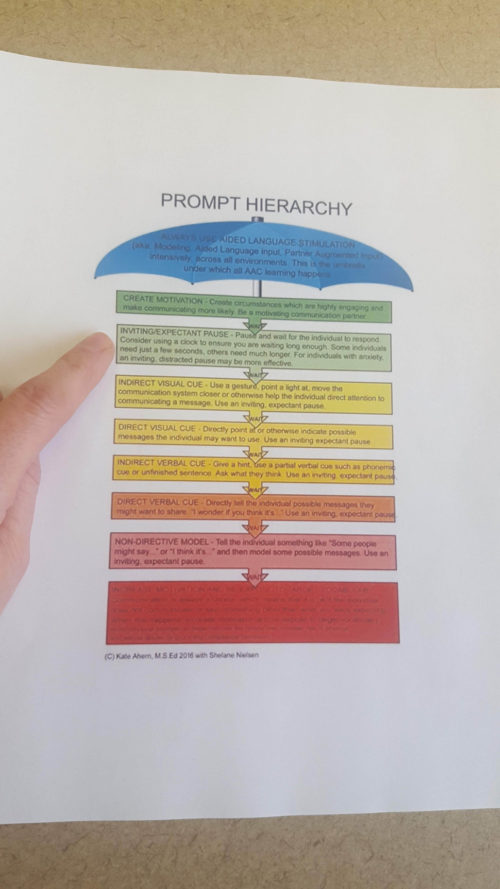 It is a least-to-most hierarchy that focuses heavily on providing aided language input, wait time, and motivation to communicate – so basically, it’s gold!
It is a least-to-most hierarchy that focuses heavily on providing aided language input, wait time, and motivation to communicate – so basically, it’s gold!
Print one (or ten), put them up around the room, attach them to datasheets, and include them in student binders. Take a minute to review it first thing in the morning and during weekly staff meetings to keep it fresh in your mind!
- Aided Language Input Tip
Aided language input, one of the other instructional methods we wouldn’t be without on a deserted island! Aided language input is necessary to provide on the daily to teach symbol location, symbol meaning, and symbol use. In a nutshell, it is talking in symbols, and it should be our goal to provide it every chance we can!
One way to work in aided language input is through self-talk. Self-talk is the act of talking about what we, the communication partners, are thinking, feeling, and seeing. And since “Here Are My Hands” is all about body parts, take some time to focus your self-talk around this vocabulary, concerning how you are feeling.
Not feeling the best today? A bit under the weather? Have a headache? Provide aided language input on the communication system while self-talking about it. And of course, you can take advantage of incorporating the target core words – GOOD, HAVE, HERE, LIKE, MY, MINE!
- “MY HEAD isn’t feeling too GOOD today.”
- “I HAVE a pain right HERE by MY ear.”
- “I feel LIKE I might be getting sick.”
To read more about how we prepare for a TELL ME week, check out our previous posts in the TELL ME About It series!
- Goal Idea – Providing shared reading and writing opportunities directly relates to IEP goals, as these activities align with various core standards. Here are some examples you may find applicable:
- ELA-Literacy.L.K.1b: Use frequently occurring nouns and verbs.
- ELA-Literacy.L.K.2c: Write a letter or letters for most consonant and short-vowel sounds (phonemes).
Be sure to check back next month as we work through the TELL ME manual and share activities, teaching strategies and implementation tips for the next book in the program, “What Do You Like?”!
References/Resources:
- http://literacyforallinstruction.ca/independent-writing-2/
- Justice, L.M., & Kaderavek, J. (2002). Using Shared storybook reading to promote emergent literacy. Teaching Exceptional Children, March/April, pp. 9-13.
- Kate Ahern blog: http://teachinglearnerswithmultipleneeds.blogspot.com/
- Search ‘Kate Ahern Prompt Hierarchy’ on Pinterest.com to find her prompt hierarchy visual
You can purchase the TELL ME program from the Attainment Company or from ASHA (bit.ly/2XF1w1r).
You can learn more about the program by watching the webinar TELL ME: AAC for the Preschool Classroom presented by Dr. Carole Zangari, available from Saltillo (bit.ly/2RNpykn).
You can find our Lesson Planning form and a blank template for “Here are My Hands” here.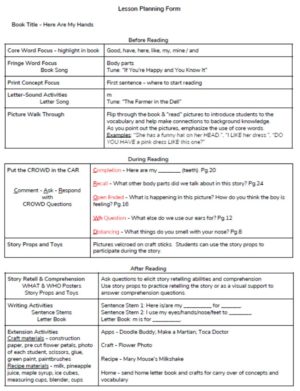
Check out the videos of us reading the book “Here Are My Hands” while providing aided language input for the target core words: https://youtu.be/piAtwHsBaUc and https://youtu.be/MrYaaSAiF2s .
Reading with Snap Core First
Reading with LAMP Words For Life
Follow us on Instagram @basscAAC and subscribe to our YouTube channel (basscAAC) for more AAC implementation ideas!
Filed under: Featured Posts, PrAACtical Thinking
Tagged With: core vocabulary, Jeanna Antrim, Maggie Judson, reading, TELL ME, writing
This post was written by Carole Zangari
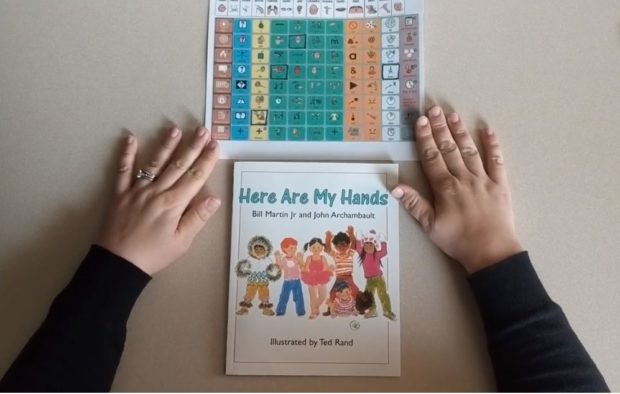
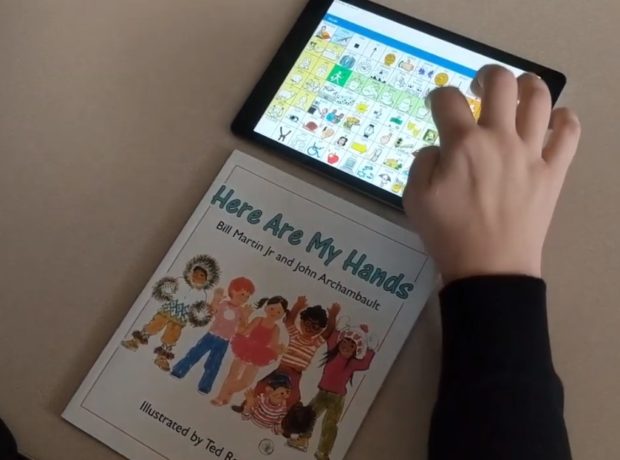

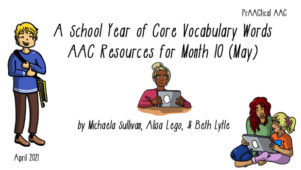
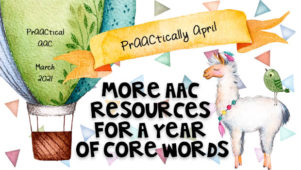
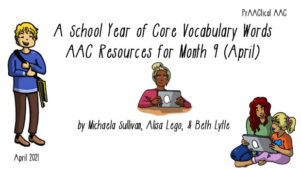
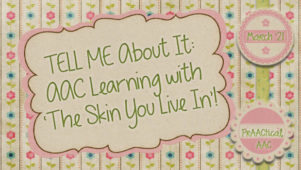
1 Comment
I liked the idea of self-management and self-talk when you weren’t feeling well with your hands and your ears and your head.